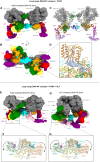PAXX binding to the NHEJ machinery explains functional redundancy with XLF
- PMID: 37256950
- PMCID: PMC10413649
- DOI: 10.1126/sciadv.adg2834
PAXX binding to the NHEJ machinery explains functional redundancy with XLF
Erratum in
-
Erratum for the Research Article: "PAXX binding to the NHEJ machinery explains functional redundancy with XLF".Sci Adv. 2023 Sep 29;9(39):eadj8489. doi: 10.1126/sciadv.adj8489. Epub 2023 Sep 29. Sci Adv. 2023. PMID: 37774037 Free PMC article. No abstract available.
Abstract
Nonhomologous end joining is a critical mechanism that repairs DNA double-strand breaks in human cells. In this work, we address the structural and functional role of the accessory protein PAXX [paralog of x-ray repair cross-complementing protein 4 (XRCC4) and XRCC4-like factor (XLF)] in this mechanism. Here, we report high-resolution cryo-electron microscopy (cryo-EM) and x-ray crystallography structures of the PAXX C-terminal Ku-binding motif bound to Ku70/80 and cryo-EM structures of PAXX bound to two alternate DNA-dependent protein kinase (DNA-PK) end-bridging dimers, mediated by either Ku80 or XLF. We identify residues critical for the Ku70/PAXX interaction in vitro and in cells. We demonstrate that PAXX and XLF can bind simultaneously to the Ku heterodimer and act as structural bridges in alternate forms of DNA-PK dimers. Last, we show that engagement of both proteins provides a complementary advantage for DNA end synapsis and end joining in cells.
Figures






References
MeSH terms
Substances
Grants and funding
LinkOut - more resources
Full Text Sources
Molecular Biology Databases
Research Materials

